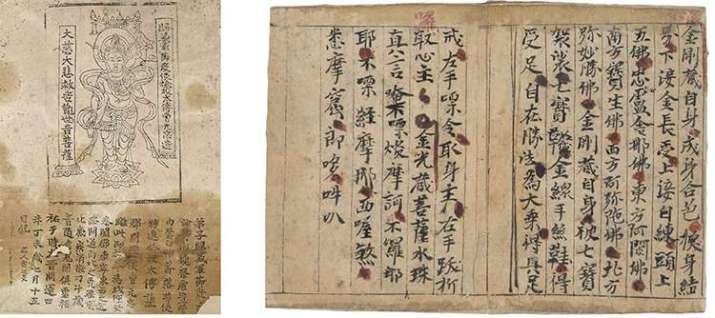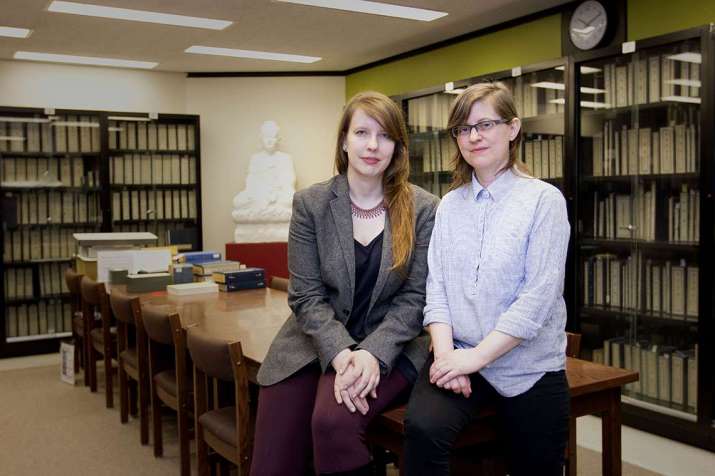NEWS
Researchers Seek to Unravel Mysteries of “Messy Manuscripts” from Dunhuang Cave
 Two manuscripts from the "Library Cave". From utoronto.ca
Two manuscripts from the "Library Cave". From utoronto.caA team of graduate researchers at the Robert H.N. Ho Family Foundation Centre for Buddhist Studies at the University of Toronto (UoT), Canada, led by Professor Amanda Goodman, a Dunhuang manuscripts specialist, are trying to unravel the mysteries of ancient Buddhist manuscripts found in Cave 17 of the Mogao Cave complex near Dunhuang in northwest China. The project is being supported by a grant from the Social Sciences and Humanities Council of Canada.
Cave 17 is also known as the “Library Cave,” as it used to store some 60,000 manuscripts, ritual equipment, fine portable paintings, dozens of statues, and banners dating mostly from the 9th to early 11th centuries. Originally a shrine for a 9th century monk named Hong Bing, the cave was sealed up in the early 11th century for reasons now unknown.
Amanda Goodman thinks the cave held “an unofficial archive of a small group of local monastics who had a large number of documents that needed to be stored, possibly for repair or to be used to replenish local libraries. Hong Bian’s memorial chapel had fallen into disrepair and the materials just kept accumulating. . . .kind of like your proverbial kitchen drawer. At a certain point, it just filled up and they sealed it.” (University of Toronto)
In 1900, a Daoist monk named Wang Yuanlu opened the cave. When he discovered the collection it held, he sold many of the manuscripts to scholar-explorers. These manuscripts are now scattered across the globe and are part of collections in London, Delhi, Paris, and St. Petersburg. A 10th-century woodblock print of a Buddhist prayer sheet, for instance, made its way to Canada, after an exchange between the Royal Ontario Museum and the British Museum in London. In an effort to preserve the original content of the cave, all manuscripts are being digitized by the International Dunhuang Project at the British Library. These digital records are freely accessible online.
 PhD student Annie Heckman (left) and Amanda Goodman, assistant professor of Chinese Buddhism (right). From utoronto.ca
PhD student Annie Heckman (left) and Amanda Goodman, assistant professor of Chinese Buddhism (right). From utoronto.caThe manuscripts are written in various languages, from 12 different linguistic groups. At present, the multilingual research team has transcribed about a dozen ritual texts. Annie Heckman, a PhD student working on the project described the work as "unravelling a mystery over time, combining different language capacities to put together the pieces of an ever-growing puzzle," (University of Toronto)
“There is a significant corpus of bilingual, even multilingual manuscripts,” said Goodman. "To read these texts, you need to know Chinese and Tibetan as well as Khotanese and Uyghur: The scribe or copyist would begin by writing down a prayer in Khotanese, but when you flip the page, you find a Tibetan prayer followed by lengthy tracts written in Chinese. There are also sketches and diagrams scattered throughout these particular manuscripts. What these texts show is that there was significant interaction, in particular between the local Tibetans and Chinese, in the 10th century, and that these Buddhist communities were engaged in a sophisticated conversation with each other." (University of Toronto)
The team is focusing not on the formal or canonical manuscripts recovered from Dunhuang, but on the “messy manuscripts;” the ritual miscellanies that found their way to London, Paris and Beijing, such as liturgical books, primers, prayer sheets, and personal notebooks. The ritual text were often jotted down on recycled paper and, according to Goodman, can provide us with a unique insight of what Buddhist study and practice looked like in ancient China.
See more
U of T researchers unravel mysteries of ancient Buddhist manuscripts (University of Toronto)
Led by Professor Amanda Goodman, a team of researchers at The Robert H.N. Ho Family Foundation Centre for Buddhist Studies is unravelling the mysteries of ancient Buddhist manuscripts (Arts & Science News)
The International Dunhuang Project (Official Website)
Related news from Buddhistdoor Global
University of Toronto Launches The Robert H. N. Ho Family Foundation Centre for Buddhist Studies and Appoints Inaugural Director
English Version of Digital Dunhuang Offers Virtual Tour of Mogao Caves
University of Chicago Digitally Restoring China’s Tianlongshan Caves With 3D Scanners
Eight Rock Carvings from Tibetan Empire Era Discovered in Chamdo Prefecture, China
Ho Center for Buddhist Studies at Stanford Releases a Series of Online Talks
Record Tourist Numbers Threaten Ancient Buddhist Art in China’s Mogao Caves
Dunhuang Airport to Close for Expansion as Popularity of Mogao Caves Takes Off
Related features from Buddhistdoor Global
From the Gobi to the Getty: Buddhist Art from Dunhuang on View in Los Angeles
Buddhism, the Pearl River Delta and the Maritime Silk Road
A General Overview of the Section “Buddhist Art and Architecture” at the IABS 2014
Dance at Dunhuang: Part One
Dance at Dunhuang: Part Two – The Case for the Feitian
Dance at Dunhuang: Part Three - The Sogdian Whirl














